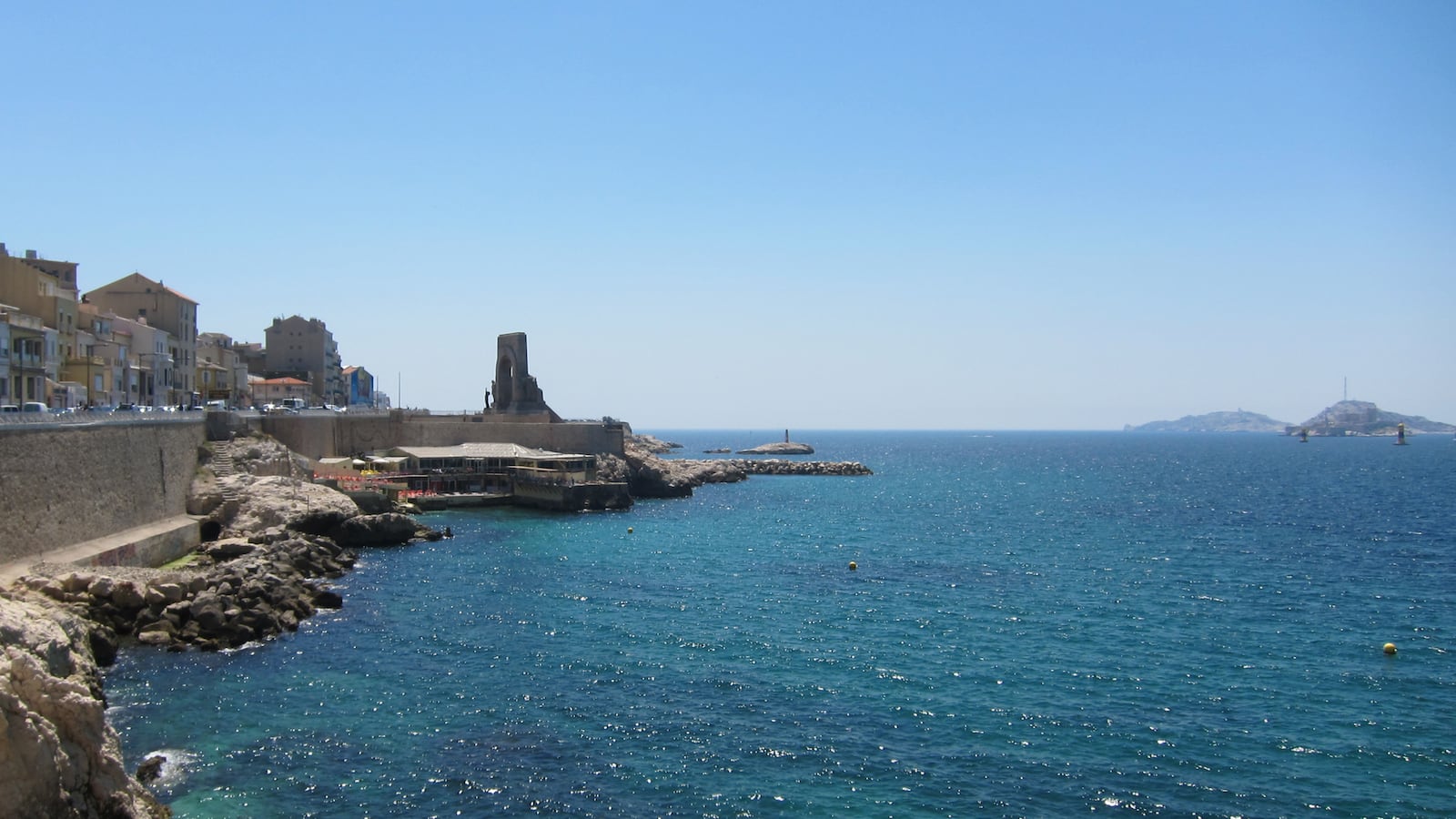I almost visited Marseille ten years ago. I arrived at the Gare de Marseille-Saint-Charles and, unencumbered by luggage, contemplated wandering around the city for a few hours before my next train. I was just out of college and living 20 miles north in Aix-en-Provence. Whereas Aix was quiet and cultured—filled with sunny café terraces, tree-lined avenues, and 18th-century hotel particuliers, Marseille was a poor, sprawling port city with a seedy reputation and high crime rate. I stood at the top of the steep staircase outside the train station, my eyes following the tangle of red-tiled roofs and narrow streets leading down to the Old Port as smells of spiced meat rose through the air and the sounds of honking car and ship horns mingled. I found the city, even at a distance, both exhilarating and terrifying. My courage faltered; I turned around and fled into the safety of the train station.

Today, Marseille is in the midst of an exciting transformation. The once-gritty harbor town was designated the 2013 European Capital of Culture, a prestigious award that has brought a flurry of investments for artistic and architectural activity to the city. Flush with an $860 million infrastructure investment (raised by European, national, and local governments), plus an additional $120 million to host cultural activities this year, the city has been on a building spree, constructing new museums, hotels, monuments, and cultural centers at a breakneck speed. EuroMediterranee—the largest urban renovation project in Southern Europe—is leading one project to transform a section of formerly derelict docks (the equivalent of 740 city blocks) near the Old Port into a thriving center of culture. The oceanfront area will eventually be home to sleek apartments, a shopping mall, and various office buildings, but for now it’s a showcase of the arts. France’s second-largest city is finally getting a chance to shine.
So this summer, ten years wiser, I decided to revisit Marseille. The trip was partially inspired by the news that XL Airways was launching the first-ever direct flight from New York City to Marseille, a mere 7.5 hours away. Best of all: tickets start at just $700 round-trip. Given the money I was saving on airfare, I decided to splurge on a stay in Marseille’s newest—and most exciting—hotel project, the five-star Intercontinental Hotel-Dieu. Housed in a stunning landmark building (a former 18th-century hospital) overlooking the Vieux Port, the Jean-Philippe Nuel-designed hotel has 192 rooms and suites surrounding a massive terrace, with postcard-perfect views of the city. Given its location—right in the heart of the city’s oldest district, Le Panier, and just a few minutes away from the port and a 10-minute walk to the city’s new museums—it seemed like the perfect home base to explore Marseille by foot.
Gazing out over the urban sprawl from the Basilica Notre Dame de la Garde, the highest point in the city, I was amazed by the sheer vastness of Marseille. Perched on the Mediterranean Sea and surrounded by mountains, Marseille feels geographically and culturally isolated from the rest of France. The city hugs the coastline, from the rocky Calanques to the east, to the beaches to the south, with the port and docks at the city center. It’s flanked by hills within the city, each with its own neighborhood. Fiercely proud, the city’s residents are more likely to call themselves “Marseillais” than “French.”

On my first morning, I met up with Mika Biermann, an artist, novelist, and regional guide who’s lived in Marseille for 30 years. Originally from Germany, Biermann moved to France to “study art and learn about life.” He never left.
“The city has changed completely. When I moved here 30 years ago, it was dangerous and dirty,” he says. “Rents were so low I could afford to rent a 2,000-square-foot apartment in the center of town.” Like many Marseille residents, he sees the recent changes in the city in a mixed light. For one, the cost of living has risen considerably. “Rents are higher, even the cost of coffee has doubled,” he laments. Then there’s all the new construction. “We recently got our first skyscraper,” Biermann recounts. “Half of the people of Marseille want to tear it down, and half of the people love it because it symbolizes this new phase of development.”
We walk through the Basilica of Notre Dame de la Garde, decorated from floor to ceiling with plaques, portraits, and replicas of ships. Each one of these, explains Biermann, was donated to the church by ship captains as a token of thanksgiving to God for saving them from storms on the sea. The church is especially sacred to sailors, who used to make the pilgrimage from the Old Port to the church (normally a 30-minute walk) on their knees to pray for protection or give thanks for their safe return.
Back outside, Biermann explains that with the influx of tourism, the local government is considering building a funicular from the Old Port up to the Basilica. Right now, there’s only one narrow road up the mountain, and it regularly becomes blocked by tour buses.
“The flavor of the city I fell in love with is changing,” he says. “But perhaps I can fall in love with the new city.”
The heart of the new city is right on the water, on the formerly abandoned docks of La Joliette. This new cultural district (at the center of the EuroMediterranee project) is home to the newest museums, as well as Marseille’s second great cathedral, the black-and-white-striped La Major.
One of the most highly anticipated additions is the Roberto Ricciotti–designed MuCEM (Museum of European Civilizations and of the Mediterranean), a 161,000-square-foot glass box covered in intricate latticework, which opened its doors in June. The museum is the first to dedicate itself to Mediterranean culture, with an impressive permanent collection of ancient and modern art from all over the Mediterranean. It also plans to host temporary exhibits that will address modern questions of gender relations, war, religion, travel, and climate change. In a clever twist of new-meets-old, the MuCEM is connected to the nearby 17th-century Fort St. Jean by footbridge. Also exciting: three-Michelin-star chef Gerald Passedat (of Le Petit Nice) recently opened Mole Passedat, a restaurant in the museum that offers three different experiences ranging from chic (La Table) to casual (Le Café), plus a Mediterranean cooking school with its own garden.
Next door, the newly opened Villa Mediterranee will host regular meetings between leaders of Mediterranean countries, as well as lectures, art exhibits, and concerts. The mod white structure, designed by Stephano Boeri, is an architectural feat in and of itself, with a 130-foot overhang hovering above a large pool. Another new museum, Musee Regards de Provence, opened this year in a former sanitation center, which used to be a required stop for immigrants coming into Marseille in the late 1940s and early ’50s. “We found the space in 2010 in total disrepair,” says Adeline Granerau, the director of the Musee Regards de Provence. “It had been abandoned for 40 years; the state wanted to destroy it, but the façade was labeled as a historical monument.” After a 14-month renovation, the space now houses a collection of art from Marseille and Provence, as well as memorabilia from its days as a sanitation center.
My days in Marseille flew by as I checked off my must-dos and must-sees: an early-morning visit to the daily fish market at the old port, where fisherman sell freshly caught sea bass, turbot, rouget, rockfish, eels, squid, and octopus (to name just a few) straight from their boats. A scenic boat ride out to the Iles de Frioul archipelago and a visit to Chateau d’If, a 16th-century prison that was immortalized in Alexandre Dumas’s The Count of Monte Cristo. Dinner at Miramar, for a multi-course bouillabaisse extravaganza that started with a steaming bowl of fish-infused soup with crisp croutes and garlicky rouille, Marseille’s red-pepper mayonnaise, and followed by a second soup, this time with six types of fish and seafood. (If I’d had more time, I would have loved to take their bouillabaisse cooking class.) A walk through the winding art-covered streets of the hilly Cours Julien district, filled with tiny restaurants, bars, bookshops, and boutiques, with a stop for a carafe of rose under the cypress trees in the café-filled square. A dinner of fluffy couscous and slow-cooked lamb at La Femina, a family-run Algerian restaurant popular with locals. A visit to the vibrant Nouilles market for mint tea and North African pastries. A walk around the steep streets of Le Panier, Marseille’s oldest district and home to many artisan ateliers. Sunset drinks to take in the magnificent view on the terrace at the Intercontinental’s Bar Le Capian. A drive along La Corniche du President John Fitzerald Kennedy and an oceanfront lunch at Restaurant Peron, one of Marseille’s top seafood spots. (They’ll lend you a chic straw hat if you sit on the terrace.). A hike in the Calanques with ocean views for miles.
Despite my previous fears, the city slowly won me over, with its Mediterranean views, fantastic food, exciting art and architectural projects, and endlessly wanderable streets. Marseille’s in the midst of a massive change, and I’m glad I had the chance to experience it in this moment. Yes, the city’s still big and loud and slightly chaotic. Their Cultural Capital title can’t scrub all the grit away. But you wouldn’t want it to—that’s part of what makes Marseille so intriguing. Biermann put it best: “It’s like making mayonnaise: add all of the ingredients and mix it up. Sometimes it works, sometimes it doesn’t.” It’s hard to say what will happen over the coming years as new projects take shape, but one thing’s for sure: there’s never been a better time to visit Marseille.





